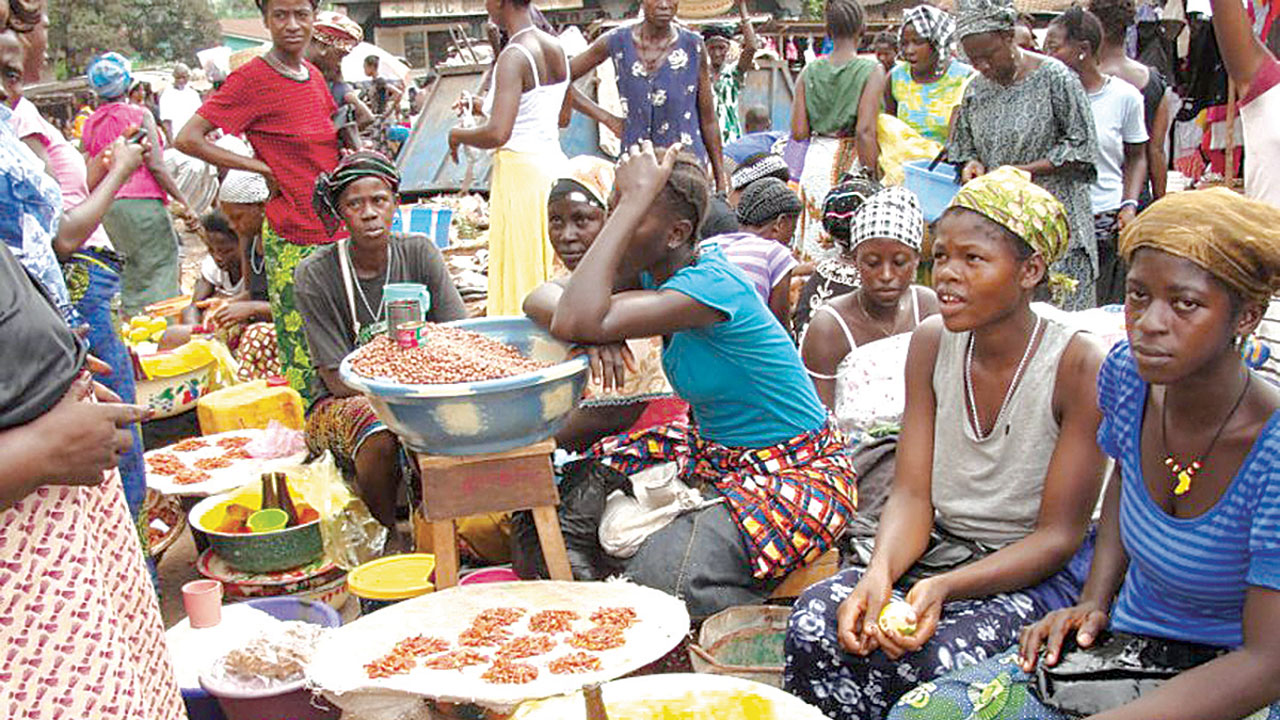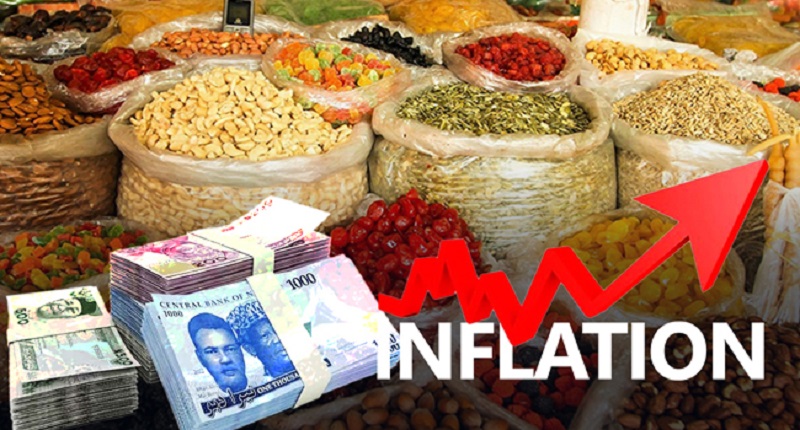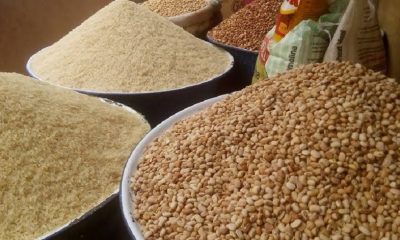World
FAO Food Price Index Remains Unchanged in November

By Adedapo Adesanya
The global prices of food remained flat, unchanged from its revised October level, as increases in the price indices for vegetable oils, dairy products, and sugar counterbalanced decreases in those of cereals and meat.
This is according to the latest Food and Agricultural Organisation (FAO) Food Price Index (FFPI) released on Friday.
The index showed that food prices averaged 120.4 points in November 2023 and stood 14.4 points (10.7 per cent) below the corresponding level one year ago.
The FAO Cereal Price Index averaged 121.0 points in November, down 3.7 points (3.0 per cent) from October and as much as 29.1 points (19.4 per cent) from its value a year ago. International prices of coarse grains fell the most, dropping by 5.6 per cent month-on-month.
The decline was dominated by a sharp fall in world maize prices, underpinned by an increase in farmers’ selling activity in Argentina and a downward pressure from seasonally higher supplies in the United States of America, where the production estimate was revised upwards.
Among other coarse grains, world prices of barley fell, while sorghum prices firmed slightly. International wheat prices also declined, by 2.4 per cent in November, mainly driven by increased seasonal supplies in Argentina and Australia, with the progress in the harvests and the continued strong competition from the Russian Federation.
Meanwhile, the FAO All Rice Price Index remained stable month-on-month in November amidst contrasting price movements across origins and market segments.
The FAO Vegetable Oil Price Index averaged 124.1 points in November, up 4.1 points (3.4 per cent) from October after declining for three consecutive months. The increase in the price index was driven by higher world palm and sunflower oil prices, more than offsetting lower soy and rapeseed oil quotations.
International palm oil prices rebounded by more than 6.0 per cent in November, chiefly underpinned by more active purchases by leading importing countries and seasonally lower outputs in major producing countries. World sunflower oil prices also rose moderately, mainly supported by a continued steady pace of import purchases.
By contrast, international soy oil prices dropped slightly on subdued global import demand, outweighing the impact of lower soybean production prospects in Brazil, while lingering abundant world supplies contributed to lower world rapeseed oil prices.
The FAO Dairy Price Index averaged 114.2 points in November, up 2.5 points (2.2 per cent) from October, marking the second consecutive monthly increase, but still down 23.2 points (16.9 per cent) from its value one year ago.
In November, international price quotations for butter and skim milk powder increased, reflecting high import demand from Northeast Asian buyers, limited inventories, and increased internal demand ahead of winter holidays in Western Europe. The same factors lifted whole milk powder prices, however, persistently subdued demand from Asian buyers, together with steady production activities in Oceania, capped the month-on-month increase.
The weakening of the United States Dollar against the Euro also contributed to the increase in world dairy prices. By contrast, world cheese prices continued to trend downward on high exportable availabilities, especially for cheddar cheese, despite seasonally tight milk deliveries in Western Europe.
The FAO Meat Price Index averaged 111.8 points in November, down marginally (0.4 per cent) from October, reflecting minor drops in the prices of poultry, pig, and bovine meats. At this level, the index value stood 2.8 points (2.4 per cent) below its corresponding value one year ago. The drop in international poultry meat prices reflected elevated supplies, mainly from Brazil, notwithstanding the challenges to production stemming from avian influenza outbreaks across many countries.
Pig meat prices were down due to persistent sluggishness in import demand in Asian markets and ample exportable availabilities in some exporters, despite a surge in internal sales in Europe ahead of the winter holidays.
Meanwhile, ample exportable supplies from Brazil and Oceania weighed on world bovine meat prices. By contrast, ovine meat prices rose slightly, mostly reflecting the impact of currency movements.
The FAO Sugar Price Index averaged 161.4 points in November, up 2.2 points (1.4 per cent) from October and as much as 47 points (41.1 per cent) from its level in the same month last year. The increase in prices in November was mostly related to heightened concerns over global export availabilities in the current season amid worsening production prospects in two leading exporters, Thailand and India, due to severe dry weather conditions associated with the El Niño event.
In addition, shipping delays from Brazil, coupled with the strengthening of the Brazilian Real against the United States Dollar, contributed to the overall increase in world sugar prices. Nevertheless, the strong pace of production in Brazil and lower international crude oil prices limited the month-on-month price increase.
World
Comviva Wins at IBSi Global FinTech Innovation Award

By Modupe Gbadeyanka
For transforming cross-border payments through its deployment with Global Money Exchange, Comviva has been named Best In-Class Cross Border Payments.
The global leader in digital transformation solutions clinched this latest accolade at the IBS Intelligence Global FinTech Innovation Award 2025.
The recognition highlights how Comviva’s mobiquity Pay is helping shape a modern cross-border payment ecosystem that stretches far beyond conventional remittance services.
Deployed as a white label Wallet Platform and launched as Global Pay Oman App, it fulfils GMEC’s dual vision—positioning itself as an innovative payment service provider while digitally extending its core money transfer business.
The solution allows GMEC to offer international money transfers alongside seamless forex ordering and other services. These capabilities sit alongside a broad suite of everyday financial services, including bill and utility payments, merchant transactions, education-related payments, and other digital conveniences — all delivered through one unified experience.
“This award is a testament to Oman’s accelerating digital transformation and our commitment to reshaping how cross-border payments serve people and businesses across the Sultanate.
“By partnering with Comviva and bringing the Global Pay Oman Super App, we have moved beyond traditional remittance services to create a truly inclusive and future-ready financial ecosystem.
“This innovation is not only enhancing convenience and transparency for our customers but is also supporting Oman’s broader vision of building a digitally empowered economy,” the Managing Director at Global Money Exchange, Subromoniyan K.S, said.
Also commenting, the chief executive of Comviva, Mr Rajesh Chandiramani, said, “Cross-border payments are becoming a daily necessity, not a niche service, particularly for migrant and trade-linked economies.
“This recognition from IBS Intelligence validates our focus on building payment platforms that combine global reach with local relevance, operational resilience and a strong user experience. The deployment with Global Money Exchange Co. demonstrates how mobiquity® Pay enables financial institutions to move beyond remittances and deliver integrated digital services at scale.”
“The deployment of mobiquity Pay for GMEC showcases how scalable, API-driven digital wallet platforms can transform cross-border payments into seamless, value-rich experiences.
“By integrating remittances, bill payments, forex services, and AI-powered engagement into a unified Super App, Comviva has reimagined customer journeys and operational agility.
“This Best-in-Class Cross-border Payments award win stands as a testament to Comviva’s excellence in enabling financial institutions to compete and grow in a digitally convergent world,” the Director for Research and Digital Properties at IBS Intelligence, Nikhil Gokhale, said.
World
Russia Renews Africa’s Strategic Action Plan

By Kestér Kenn Klomegâh
At the end of an extensive consultation with African foreign ministers, Russian Foreign Minister, Sergey Lavrov, has emphasized that Moscow would advance its economic engagement across Africa, admittedly outlining obstacles delaying the prompt implementation of several initiatives set forth in Strategic Action Plan (2023-2026) approved in St. Petersburg during the Russia-Africa Summit.
The second Ministerial Conference, by the Russian Foreign Ministry with support from Roscongress Foundation and the Arab Republic of Egypt, marked an important milestone towards raising bilateral investment and economic cooperation.
In Cairo, the capital city of the Arab Republic of Egypt, Lavrov read out the final resolution script, in a full-packed conference hall, and voiced strong confidence that Moscow would achieve its strategic economic goals with Africa, with support from the African Union (AU) and other Regional Economic blocs in the subsequent years. Despite the complexities posed by the Russia-Ukraine crisis, combined with geopolitical conditions inside the African continent, Moscow however reiterated its position to take serious steps in finding pragmatic prospects for mutual cooperation and improve multifaceted relations with Africa, distinctively in the different sectors: in trade, economic and investment spheres, education and culture, humanitarian and other promising areas.
The main event was the plenary session co-chaired by Russian Foreign Minister Sergey Lavrov and Egyptian Minister of Foreign Affairs, Emigration, and Egyptians Abroad Bashar Abdelathi. Welcome messages from Russian President Vladimir Putin and Egyptian President Abdelhak Sisi were read.
And broadly, the meeting participants compared notes on the most pressing issues on the international and Russian-African agendas, with a focus on the full implementation of the Russia-Africa Partnership Forum Action Plan for 2023-2026, approved at the second Russia-Africa Summit in St. Petersburg in 2023.
In addition, on the sidelines of the conference, Lavrov held talks with his African counterparts, and a number of bilateral documents were signed. A thematic event was held with the participation of Russian and African relevant agencies and organizations, aimed at unlocking the potential of trilateral Russia-Egypt-Africa cooperation in trade, economic, and educational spheres.
With changing times, Africa is rapidly becoming one of the key centers of a multipolar world order. It is experiencing a second awakening. Following their long-ago political independence, African countries are increasingly insisting on respect for their sovereignty and their right to independently manage their resources and destiny. Based on these conditions, it was concluded that Moscow begins an effective and comprehensive work on preparing a new three-year Cooperation and Joint Action Plan between Russia and Africa.
Moreover, these important areas of joint practical work are already detailed in the Joint Statement, which was unanimously approved and will serve as an important guideline for future work. According to reports, the Joint Statement reflects the progress of discussions on international and regional issues, as well as matters of global significance.
Following the conference, the Joint Statement adopted reflects shared approaches to addressing challenges and a mutual commitment to strengthening multifaceted cooperation with a view to ensuring high-quality preparation for the third Russia-Africa Summit in 2026.
On December 19-20, the Second Ministerial Conference of the Russia-Africa Partnership Forum was held in Cairo, Egypt. It was held for the first time on the African continent, attended by heads and representatives of the foreign policy ministries of 52 African states and the executive bodies of eight regional integration associations.
World
TikTok Signs Deal to Avoid US Ban

By Adedapo Adesanya
Social media platform, TikTok’s Chinese owner ByteDance has signed binding agreements with United States and global investors to operate its business in America.
Half of the joint venture will be owned by a group of investors, including Oracle, Silver Lake and the Emirati investment firm MGX, according to a memo sent by chief executive, Mr Shou Zi Chew.
The deal, which is set to close on January 22, 2026 would end years of efforts by the US government to force ByteDance to sell its US operations over national security concerns.
It is in line with a deal unveiled in September, when US President Donald Trump delayed the enforcement of a law that would ban the app unless it was sold.
In the memo, TikTok said the deal will enable “over 170 million Americans to continue discovering a world of endless possibilities as part of a vital global community”.
Under the agreement, ByteDance will retain 19.9 per cent of the business, while Oracle, Silver Lake and Abu Dhabi-based MGX will hold 15 per cent each.
Another 30.1 per cent will be held by affiliates of existing ByteDance investors, according to the memo.
The White House previously said that Oracle, which was co-founded by President Trump’s supporter Larry Ellison, will license TikTok’s recommendation algorithm as part of the deal.
The deal comes after a series of delays.
Business Post reported in April 2024 that the administration of President Joe Biden passed a law to ban the app over national security concerns, unless it was sold.
The law was set to go into effect on January 20, 2025 but was pushed back multiple times by President Trump, while his administration worked out a deal to transfer ownership.
President Trump said in September that he had spoken on the phone to China’s President Xi Jinping, who he said had given the deal the go ahead.
The platform’s future remained unclear after the leaders met face to face in October.
The app’s fate was clouded by ongoing tensions between the two nations on trade and other matters.
-

 Feature/OPED6 years ago
Feature/OPED6 years agoDavos was Different this year
-
Travel/Tourism9 years ago
Lagos Seals Western Lodge Hotel In Ikorodu
-

 Showbiz3 years ago
Showbiz3 years agoEstranged Lover Releases Videos of Empress Njamah Bathing
-

 Banking7 years ago
Banking7 years agoSort Codes of GTBank Branches in Nigeria
-

 Economy3 years ago
Economy3 years agoSubsidy Removal: CNG at N130 Per Litre Cheaper Than Petrol—IPMAN
-

 Banking3 years ago
Banking3 years agoFirst Bank Announces Planned Downtime
-

 Banking3 years ago
Banking3 years agoSort Codes of UBA Branches in Nigeria
-

 Sports3 years ago
Sports3 years agoHighest Paid Nigerian Footballer – How Much Do Nigerian Footballers Earn






















